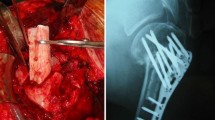Abstract.
Harvesting autologous bone graft from the iliac crest is associated with considerable secondary morbidity. Bone graft substitutes such as porous ceramics are increasingly used for spinal surgery. This paper presents the results of an animal study in which β-tricalcium phosphate (β-TCP) bone substitutes were used for anterior spinal surgery in sheep and baboons. The presented baboon study also investigated the effect of impregnating the ceramic material with transforming growth factor (TGF). In the first study, using the sheep model, a stand-alone instrumented anterior fusion was performed. The animals were randomized into three treatment groups: autologous bone, β-TCP granules, and sham group. The results were analyzed biomechanically and histologically at three survival intervals: 8, 16 and 32 weeks. An additional animal group was added later, with ceramic pre-filled implants. In the second study, a baboon model was used to assess the osteointegration of a 15-mm-diameter porous β-TCP block into the vertebral body. The experiment was partially motivated by a new surgical procedure proposed for local bone graft harvest. Three treatment groups were used: β-TCP plug, β-TCP plug impregnated with TGF-β3, and a sham group with empty defect. The evaluation for all animals included computer tomograms at 3 and 6 months, as well as histology at 6 months. In the sheep model, the mechanical evaluation failed to demonstrate differences between treatment groups. This was because massive anterior bone bridges formed in almost all the animals, masking the effects of individual treatments. Histologically, β-TCP was shown to be a good osteoconductor. While multiple signs of implant micromotion were documented, pre-filling the cages markedly improved the histological fusion outcomes. In the baboon study, the β-TCP plugs were completely osteointegrated at 6 months. For the group that used ceramic plugs impregnated with TGF-β3, no incremental advantage was seen as a result of this particular application. However, TGF-β3 is a potent growth factor at a very low dose. Not only does it speed up the ceramic material resorption, but it is also responsible for massive regional new bone formation. More experiments are required to better understand the biological effects of this growth factor in relation to bone formation, and to be able to take clinical advantage of them.
Similar content being viewed by others
Author information
Authors and Affiliations
Additional information
Electronic Publication
Rights and permissions
About this article
Cite this article
Steffen, T., Stoll, T., Arvinte, T. et al. Porous tricalcium phosphate and transforming growth factor used for anterior spine surgery. Eur Spine J 10 (Suppl 2), S132–S140 (2001). https://doi.org/10.1007/s005860100325
Received:
Accepted:
Issue Date:
DOI: https://doi.org/10.1007/s005860100325




